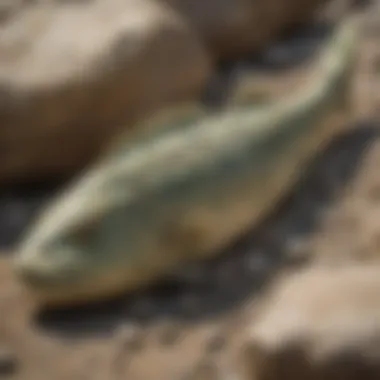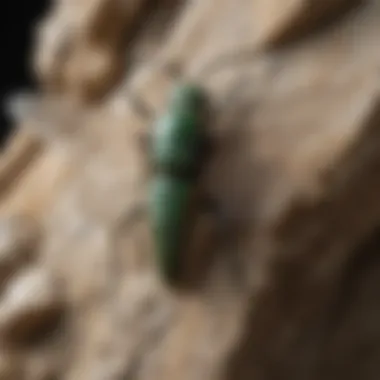Unveiling the Enigmatic Green River Fossil: A Geological Marvel


Geological Insights
The exploration of the Green River Fossil unravels a captivating journey through geological time, offering a window into a world long past. Delving into the intricate details of this geological treasure trove allows us to peer into the very fabric of the Earth's history, understanding the forces and processes that have shaped our planet over millennia.
Geological Formations and Processes
The Green River Formation, renowned for its rich fossil record, showcases a tapestry of ancient ecosystems frozen in time. This formation, dating back to the Eocene epoch, presents a unique opportunity to study the flora and fauna of a bygone era, providing invaluable insights into prehistoric life.
Examining the sedimentary layers of the Green River Formation reveals a myriad of depositional environments, from tranquil lakes to meandering rivers, each preserving a distinct snapshot of the ancient landscape. By deciphering the stratigraphic signatures within these formations, geologists can piece together the environmental conditions that prevailed during the deposition of these sediments, offering a glimpse into the changing tides of the past.
Historical Significance of Rocks and Fossils
The rocks and fossils retrieved from the Green River Formation hold a profound historical significance, acting as tangible remnants of a world long gone. They provide crucial evidence for understanding evolutionary processes, biodiversity patterns, and paleoclimate conditions prevalent during the Eocene epoch.
These ancient relics serve as time capsules, encapsulating moments frozen in time, allowing scientists to reconstruct ancient ecosystems with remarkable precision. By carefully studying the fossils excavated from the Green River Formation, researchers can unlock the secrets of prehistoric life, piecing together the puzzle of Earth's evolutionary history.
Notable Discoveries in the Field
The Green River Fossil site has yielded a treasure trove of scientific discoveries that have reshaped our understanding of Earth's past. From exquisitely preserved plant specimens to impeccably detailed vertebrate fossils, each find offers a new chapter in the saga of prehistoric life.
Among the notable discoveries from the Green River Formation are fossilized fish species, such as Knightia and Diplomystus, showcasing the remarkable diversity of aquatic life that once thrived in these ancient waters. Additionally, the discovery of insect remains and plant fossils paints a vivid picture of the terrestrial ecosystems that flourished alongside these prehistoric water bodies.
Reconstructing the past from these fossilized remnants requires meticulous attention to detail and a keen eye for discerning patterns within the geological record. Through collaboration and interdisciplinary research, scientists continue to unravel the mysteries contained within the Green River Fossil, shedding light on a bygone era that continues to captivate and inspire us today.
Introduction to Green River Fossil
Delving into the intricacies of Green River Fossils opens a gateway to the ancient past, unveiling a world long forgotten but preserved in stone. The significance of Green River Fossils lies in their ability to act as time capsules, offering a glimpse into prehistoric ecosystems and the creatures that once roamed the Earth. By understanding the formation, importance, and collection of these fossils, we embark on a journey of unraveling mysteries spanning millions of years.
Understanding Fossilization Process
Formation of Green River Fossil


The Formation of Green River Fossils is a complex process that involves the interplay of geological factors and biological remains. Over time, sediments from the Green River Formation encapsulated organic materials, effectively preserving them through mineralization. This unique preservation method captures intricate details of ancient organisms, from delicate plant structures to the scales of prehistoric fish. The exceptional fossilization quality of the Green River Formation sets it apart as a valuable resource for paleontologists and researchers seeking insights into the world long past.
Importance of Green River Fossil
Scientific Significance
The Scientific Significance of Green River Fossils transcends mere artifacts; they represent a tangible link to Earth's history and evolution. Through detailed examination, scientists can reconstruct past environments, identify extinct species, and trace evolutionary patterns. Green River Fossils contribute significantly to our understanding of biodiversity, climate change, and the mechanisms driving Earth's biological evolution. Their scientific value extends beyond discovery, shaping our knowledge of the natural world.
Contribution to Evolutionary Studies
Within the realm of Evolutionary Studies, Green River Fossils play a crucial role in piecing together the puzzle of life's development over millions of years. By analyzing fossilized flora and fauna, researchers can track evolutionary changes, identify evolutionary trends, and study adaptations in response to environmental shifts. The unique specimens from the Green River Formation offer unparalleled insights into evolutionary processes, enriching our comprehension of how life has transformed through geological time scales.
Exploration of Green River Formation
In the realm of paleontology, the Exploration of Green River Formation stands as a crucial endeavor, offering a gateway to understanding the ancient past preserved within its geological layers. This section delves into the significance of exploring the Green River Formation, shedding light on the processes that have culminated in the remarkable fossil record found within its depths. By uncovering the secrets hidden within this prehistoric landscape, researchers and enthusiasts alike can piece together a narrative of life long gone, providing valuable insights into the Earth's history and evolution. The Exploration of Green River Formation not only unravels the mysteries of the past but also serves as a testament to the resilience and adaptability of life forms across millennia.
Geological Context
Ancient Lake Environment
The Ancient Lake Environment encapsulates a pivotal aspect of the Green River Formation, showcasing a snapshot of primordial ecosystems frozen in time. This unique setting, characterized by expansive water bodies teeming with diverse flora and fauna, offers a rare glimpse into the ecological dynamics of bygone eras. The tranquil yet dynamic nature of the Ancient Lake Environment provides researchers with a rich tapestry of fossil remnants, enabling them to reconstruct the intricate web of life that once thrived in these ancient waters. Despite the challenges of preservation over millions of years, the Ancient Lake Environment embodies a treasure trove of information, unraveling the complexities of prehistoric biodiversity.
Depositional Processes
Within the Green River Formation, Depositional Processes play a pivotal role in shaping the distribution and preservation of fossilized remains. These processes, marked by a meticulous interplay of sedimentation and geological forces, create a conducive environment for the entombment and conservation of organic material. The stratigraphic layers resulting from these intricate Depositional Processes serve as a temporal archive, recording the ebb and flow of ancient ecosystems with remarkable clarity. By understanding the mechanisms underlying deposition within the Green River Formation, scientists can decipher the tiniest details of prehistoric life, unraveling the mysteries of evolution and environmental change embedded within the sedimentary record.
Diversity of Fossilized Species
Fish Fossils
Among the diverse array of fossils found within the Green River Formation, Fish Fossils stand out as prominent indicators of the region's aquatic heritage. These exquisitely preserved remnants offer a window into the evolutionary history of fish species, highlighting adaptations and morphological innovations that have sculpted aquatic life over millennia. The abundance and variety of Fish Fossils within the Green River Formation provide researchers with valuable insights into ancient aquatic ecosystems, allowing them to piece together the puzzle of prehistoric food webs and environmental conditions.
Plant and Insect Specimens


In addition to fish, the Green River Formation boasts an impressive array of Plant and Insect Specimens that offer a holistic view of terrestrial life during prehistoric times. These well-preserved botanical and entomological remnants capture the essence of ancient plant diversity and insect ecology, painting a vivid picture of the flora and fauna that once inhabited the verdant landscapes surrounding the ancient lakes. Through the study of Plant and Insect Specimens, researchers can unravel the interplay between plants, insects, and their environment, reconstructing the delicate balance that sustained these ancient ecosystems.
Uncovering Paleontological Treasures
Fossil Preparation Techniques
The meticulous process of Fossil Preparation Techniques plays a critical role in unveiling the beauty and intricacy of fossilized specimens entombed within the Green River Formation. Through delicate cleaning, stabilizing, and restoration methods, paleontologists can reveal the stunning details preserved within ancient fossils, enabling a closer examination of prehistoric life forms. The artistry and precision of Fossil Preparation Techniques not only enhance the visual appeal of fossils but also provide valuable scientific data, enriching our understanding of evolutionary history and paleoecology.
Tools for Excavation
Equipped with a diverse arsenal of Tools for Excavation, researchers navigate the challenging terrain of the Green River Formation to unearth hidden treasures buried deep within the rocks. From delicate brushes and chisels to advanced imaging technologies, these excavation tools play a crucial role in recovering fragile fossils with precision and care. The strategic application of Tools for Excavation ensures minimal damage to valuable specimens while maximizing the retrieval of essential data, facilitating comprehensive analyses and detailed reconstructions of ancient life forms.
Preservation and Conservation Efforts
Preservation and Conservation Efforts play a pivotal role in safeguarding the valuable Green River fossils. By meticulously preserving these ancient relics, scientists and researchers can unravel the mysteries of prehistoric life for future generations. Through stringent conservation measures, the integrity and scientific value of these fossils are maintained, contributing to a deeper understanding of Earth's history and evolution. Conservation efforts also serve to safeguard these invaluable specimens from environmental degradation and illegal trade.
Challenges in Preserving Fossils
- Environmental Factors: The impact of environmental factors on fossil preservation cannot be understated. Factors such as temperature fluctuations, humidity levels, and geological processes influence the long-term survival of fossils. Understanding these environmental variables is essential for developing effective preservation strategies. By acknowledging the interplay between the environment and fossil integrity, researchers can better protect and conserve these delicate artifacts. Maintaining stable environmental conditions is crucial for ensuring the longevity and authenticity of Green River fossils.
- Legal Regulations: Legal regulations act as a cornerstone for the protection of Green River fossils. These regulations govern the collection, transportation, and ownership of fossil specimens to prevent exploitation and preserve scientific integrity. By complying with legal frameworks, museums and collectors contribute to the ethical acquisition and dissemination of fossil knowledge. Legal measures also deter unauthorized excavation and commercial trading of fossils, thus safeguarding the cultural and scientific heritage of the Green River formation.
Role of Museums and Institutions
Museums and institutions play a crucial role in curating and disseminating information about Green River fossils. Through meticulous curation practices, museums ensure the proper documentation, storage, and display of fossil specimens. This not only preserves the scientific value of the fossils but also enhances public education and engagement. Educational outreach programs conducted by museums offer valuable insights into the significance of Green River fossils, sparking interest in paleontology and geology. By partnering with educational institutions, museums amplify the impact of fossil research and promote a deeper understanding of Earth's ancient past.
Collecting and Studying Green River Fossils
Starting with the essential topic of Collecting and Studying Green River Fossils, this section uncovers the crucial relevance of meticulously acquiring and examining these remarkable artifacts. Understanding the significance of careful collection and detailed study processes is paramount in unraveling the mysteries that the Green River Fossils hold. Scientific enthusiasts and researchers alike benefit greatly from engaging in these practices, as they contribute to a deeper comprehension of prehistoric life and geological evolution. The process of collecting and studying Green River Fossils involves meticulous attention to detail and a keen eye for uncovering valuable insights into the past.
Ethical Considerations
Responsible Collection Practices


Delving into Responsible Collection Practices, we shed light on the conscientious approach required in handling and preserving Green River Fossils. Emphasizing ethical guidelines such as respectful excavation techniques and adherence to legal regulations ensures the sustainability of fossil resources and safeguards their integrity for future generations. The meticulous care taken during collection not only preserves the fossils effectively but also honors the legacy they represent, fostering a sense of responsibility and reverence towards these ancient relics. Adopting Responsible Collection Practices stands as a cornerstone in fostering a sustainable and ethical approach to paleontological research.
Ethical Dilemmas
Exploring the realm of Ethical Dilemmas surrounding Green River Fossils underscores the complex challenges inherent in balancing research pursuits with conservation efforts. Addressing dilemmas related to excavation impact, specimen ownership, and commercial interests requires a delicate consideration of multiple perspectives. Navigating these ethical gray areas demands a nuanced understanding of the intersection between scientific exploration and ethical responsibility. Tackling such dilemmas head-on encourages transparency and critical reflection within the scientific community, paving the way for more ethically informed practices.
Research Opportunities
Paleontological Studies
Uncovering the vast potential of Paleontological Studies in Green River Fossil research unveils groundbreaking avenues for understanding ancient ecosystems and evolutionary processes. By delving into the morphology and ecological interactions of fossilized species, researchers glean valuable insights into the dynamic history of life on Earth. The meticulous analysis of paleontological data provides a bridge between the past and present, offering substantial contributions to scientific understanding and education. Engaging in Paleontological Studies not only enriches our knowledge of prehistoric environments but also informs conservation practices for current biodiversity.
Climate Change Research
Embracing the intersection of Green River Fossils with Climate Change Research opens up new horizons in understanding past climatic variations and their implications for the future. Examining fossilized flora and fauna within the context of shifting environmental conditions sheds light on patterns of adaptation and resilience displayed by ancient organisms. By correlating paleontological data with climate change models, researchers chart a course towards deciphering the impact of environmental shifts on biodiversity over time. Climate Change Research in the context of Green River Fossils serves as a critical tool in contextualizing contemporary climate challenges and fostering sustainable practices.
Collaborative Efforts in Fossil Analysis
Interdisciplinary Approaches
Unpacking the significance of Interdisciplinary Approaches in fossil analysis highlights the synergy achieved through combining diverse scientific perspectives. Integrating fields such as paleontology, geology, and geochemistry enhances the depth and accuracy of fossil interpretations, leading to comprehensive insights into past ecosystems. Collaboration among experts from different disciplines fosters a holistic understanding of Green River Fossils, enriching research outcomes and broadening the scope of scientific inquiry. Embracing Interdisciplinary Approaches promotes a synergistic approach to fossil analysis, propelling discoveries and advancements within the scientific community.
Data Sharing Initiatives
Exploring the collaborative landscape of Data Sharing Initiatives in Green River Fossil research showcases the transformative power of shared knowledge and resources. By establishing platforms for the dissemination of research findings and data sets, scientists promote transparency and facilitate discoveries across international boundaries. The open exchange of information ensures that research outcomes are accessible to a global audience, fostering continuous dialogue and innovation within the scientific community. Engaging in Data Sharing Initiatives not only accelerates scientific progress but also cultivates a culture of collaboration and mutual enrichment among researchers.
Conclusion: Embracing the Legacy of Green River Fossil
In concluding this exploration of the Green River fossil, we must internalize the profound importance of preserving and studying these geological treasures. As custodians of Earth's history, we bear the responsibility of unraveling the mysteries hidden within the layers of time. Embracing the legacy of the Green River fossil offers us a glimpse into the ancient past, fostering a deeper connection with the planet's evolutionary journey. By valuing and protecting these relics, we honor the intricate web of life that has shaped our world.
Appreciating Earth's History
Reflection on Geological Time
Delving into the concept of geological time provides us with a humbling perspective on the vastness of Earth's history. Reflecting on the eons that have passed allows us to contextualize our existence within the grand timeline of evolution. The gradual changes witnessed over millennia serve as a stark reminder of the impermanence of life and the enduring legacy left by each passing epoch. Embracing the notion of geological time affords us a deeper understanding of our place in the intricate tapestry of life's evolution, urging us to contemplate the forces that have shaped the world as we know it.
Inspiration for Future Discoveries
Looking towards the future, the Green River fossil acts as a catalyst for sparking innovative discoveries in the field of paleontology. The insights gleaned from these ancient remnants inspire researchers to push the boundaries of scientific inquiry, embarking on expeditions to unearth new revelations about prehistoric life. The Green River fossil serves not only as a historical artifact but as a beacon guiding future explorations into the depths of Earth's past. By kindling a sense of curiosity and wonder, these fossils propel us towards exciting prospects for unraveling the enigmas that continue to captivate the scientific community and fuel our quest for knowledge.







